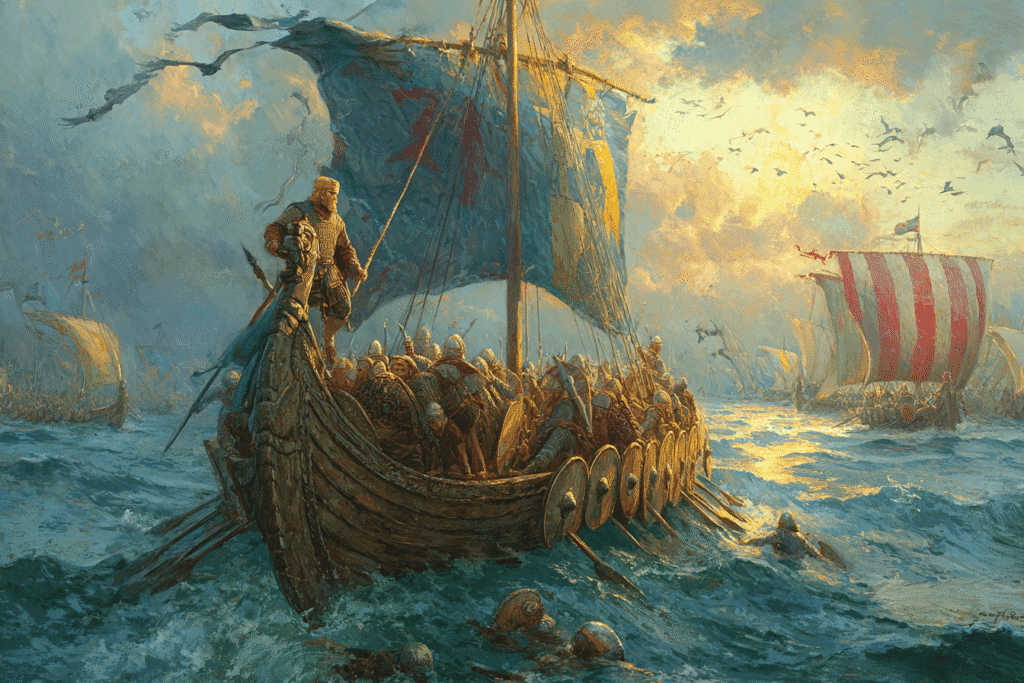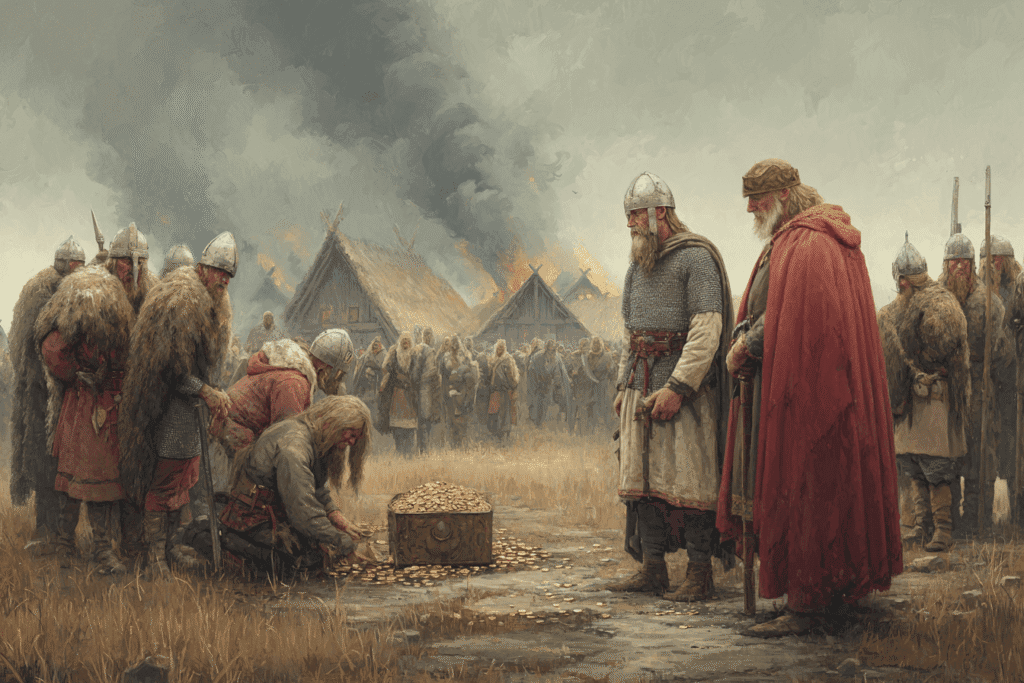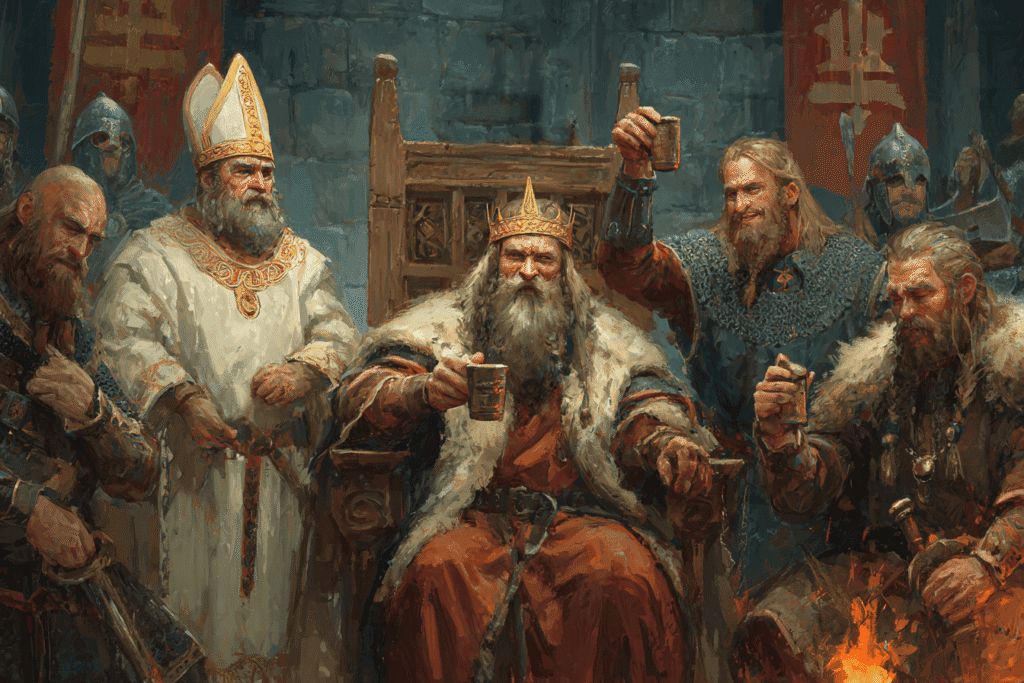
Sweyn Forkbeard, known in Old Norse as Sveinn Haraldsson tjúguskegg, stands as one of the most formidable and enigmatic figures of the Viking Age. His life, marked by rebellion, conquest, and ambition, shaped the destinies of Denmark, Norway, and England. Though his reign over England was brief, his impact was profound, setting the stage for the rise of his son, Cnut the Great, and the formation of a North Sea empire.
Origins and Early Life
Sweyn was born around 960 AD in Denmark, the eldest son of Harald Bluetooth, the king credited with uniting Denmark and introducing Christianity to his people. Sweyn’s mother was Gyrid, a noblewoman whose lineage further anchored Sweyn in the royal traditions of Scandinavia. From an early age, Sweyn was immersed in the turbulent world of Viking politics, where alliances were fickle, and power was often won by the sword.
Sweyn’s nickname, “Forkbeard,” derived from his distinctive long, cleft beard – a feature he wore with pride and which became emblematic of his fierce persona. Educated in both the martial and practical arts, Sweyn was as comfortable wielding a sword as he was overseeing the construction of ships, skills that would serve him well in the years to come.
Rebellion and Rise to Power
The seeds of Sweyn’s ambition were sown in a dramatic and violent rupture with his own father. In the late 980s, Sweyn, alongside the legendary Jomsviking leader Palnatoke, rebelled against Harald Bluetooth. The reasons for this revolt remain a subject of debate – some cite dynastic rivalry, others point to religious tensions as Sweyn, though baptized a Christian, may have harbored pagan sympathies. The conflict culminated in Harald’s exile and subsequent death in 986 or 987, leaving Sweyn the undisputed king of Denmark at just 26 years old.

The Norwegian Challenge
Sweyn inherited from his father not only the Danish crown but also claims to Norwegian territory, particularly the region of Viken, which Harald had controlled since around 970.Norway, however, was not easily held. After Harald Bluetooth’s defeat by a German army in 974, Danish influence in Norway waned. The Norwegian throne was claimed by Olaf Tryggvason, a charismatic and zealous Christian king who sought to unite Norway and stamp out paganism. Olaf’s rule was marked by aggressive missionary efforts and a series of political marriages and alliances, but he made powerful enemies in the process.
Sweyn Forkbeard was one of them. The animosity between the two kings was personal as well as political. According to the sagas, Olaf’s ill-fated marriage proposal to Sigrid the Haughty (who later encouraged Swein to go to war) and his problematic marriage to Sweyn’s sister, Thyri, provided the spark for conflict. Sigrid, having been insulted by Olaf, reportedly goaded Sweyn into action.

Alliance and the Battle of Svolder
Sweyn was not alone in his ambitions. He forged a powerful alliance with King Olof Skötkonung of Sweden and Eirik Hákonarson, the Jarl of Lade, a major Norwegian noble. Together, they plotted to bring down Olaf Tryggvason and restore Danish hegemony over Norway.
The decisive moment came in September of either 999 or 1000, at the Battle of Svolder. As Olaf sailed home from an expedition, his fleet was ambushed in the western Baltic Sea by the combined forces of Swein, Olof, and Eirik. The battle was fierce and bloody. Olaf, seeing defeat was inevitable, leapt into the sea and drowned, denying his enemies the satisfaction of capturing him.

With Olaf dead, Norway was divided among the victors. Swein regained direct control of the Viken district, while King Olof of Sweden received several districts in Trondheim and other regions, which he entrusted to his son-in-law, Jarl Svein Hákonarson. The rest of Norway was ruled by Eirik Hákonarson as Swein’s vassal.
The division of Norway was not merely a matter of drawing lines on a map. Sweyn’s allies, the Jarls Eirik and Svein, proved to be strong and capable rulers. They maintained order and prosperity, and while they nominally adopted Christianity, they allowed religious freedom, leading to a backlash against Olaf’s earlier missionary zeal. This pragmatic approach helped stabilize the region and ensured the loyalty of the local chieftains. Sweyn’s control over Norway was not absolute, but it was effective.
The English Campaigns Begin
Sweyn’s ambitions, however, extended far beyond Scandinavia. The wealth and fractured politics of Anglo-Saxon England proved irresistible to the Viking king. From the early 990s, Sweyn launched a series of devastating raids along the English coast, often in alliance with other Norse leaders such as Olaf Tryggvason. These raids were characterized by their ferocity – towns and villages from East Anglia to Hampshire were plundered, and the English, unable to mount an effective defense, resorted to paying vast sums of Danegeld in a desperate bid for peace.
The payments, however, only emboldened Sweyn and his followers. The Danes continued their incursions, settling in the north of England and gradually eroding the authority of the English king, Æthelred the Unready. Tensions reached a boiling point in 1002, when Æthelred, in a bid to rid his kingdom of the Danish presence, ordered the infamous St. Brice’s Day Massacre. Among the victims was Sweyn’s own sister, Gunhilde, a personal tragedy that transformed Sweyn’s campaigns from opportunistic raids into a war of vengeance.

A War of Vengeance
Sweyn’s response to the massacre was swift and merciless. In 1003, he landed in England with a formidable army, unleashing a campaign of terror and destruction that eclipsed all previous raids. Towns in Devon, Wiltshire, Hampshire, and East Anglia were sacked, their inhabitants slaughtered or enslaved. Æthelred, unable to resist, once again resorted to paying Danegeld, but the cycle of violence and extortion continued unabated.
Throughout the first decade of the 11th century, Sweyn’s forces returned to England time and again, each time extracting greater tribute and sowing deeper discord among the English nobility. The relentless pressure weakened the Anglo-Saxon state, paving the way for Sweyn’s ultimate ambition: the conquest of the English throne.
The Conquest of England
In 1013, Sweyn launched his final and most audacious campaign. Landing at Sandwich in Kent, he led his army north, securing the submission of Northumbria and the Danelaw before turning south towards Wessex. The English resistance crumbled, morale collapsed, and faith in Æthelred’s leadership evaporated. The king, isolated and fearful, retreated to London, but even the great city could not withstand the Viking onslaught.
As Sweyn’s forces closed in, the English earls—disillusioned with Æthelred’s ineffectiveness and fearful of Viking reprisals – made a momentous decision. On Christmas Day 1013, they declared Sweyn Forkbeard king of England, forcing Æthelred to flee into exile, first to the Isle of Wight and then to Normandy. For the first time, a Danish king sat upon the throne of England, his authority recognized across the land.

A Brief and Mysterious Reign
Sweyn’s triumph, however, was short-lived. He ruled England for just over five weeks, never formally crowned, before dying suddenly at his capital in Gainsborough, Lincolnshire, on February 3, 1014. The circumstances of his death remain shrouded in mystery. Some accounts claim he fell from his horse; others suggest he died of apoplexy. A later legend, rich in medieval imagination, holds that Sweyn was murdered in his sleep by the ghost of St. Edmund, the martyred king of East Anglia, who returned from the grave to exact divine retribution.
Sweyn was initially buried in England, but his body was later exhumed and reinterred at Roskilde Cathedral in Denmark, a fitting resting place for a king who had united the Scandinavian world and shaken the foundations of England.
Legacy and the North Sea Empire
Though Sweyn’s reign over England was fleeting, his legacy was immense. He was the first Viking king to conquer and rule England, a feat that had eluded generations of Norse leaders before him. His campaigns shattered the Anglo-Saxon state, paving the way for his son, Cnut the Great, to establish a North Sea empire that would span Denmark, Norway, and England – a political entity that, for a brief moment, rivaled the greatest kingdoms of medieval Europe.
Sweyn’s children carried forward his legacy. His son Harald II succeeded him as king of Denmark, while Cnut would go on to become one of the most powerful rulers of the age, remembered as much for his wisdom and statesmanship as for his martial prowess. Sweyn’s daughter, Estrid Svendsdatter, would also play a significant role in the dynastic politics of Scandinavia.

Character and Reputation
Sweyn Forkbeard’s reputation is that of a ruthless and ambitious warlord, a man shaped by the brutal realities of his time. Yet he was also a shrewd political operator, capable of forging alliances and exploiting the divisions of his enemies. His willingness to rebel against his own father, his relentless pursuit of vengeance for his sister’s death, and his unyielding ambition set him apart from his contemporaries.
Despite his baptism and nominal Christianity, Sweyn’s actions often reflected the older, pagan values of honor, vengeance, and personal glory. He was a king who understood the power of fear and the importance of reputation, and he wielded both with deadly effectiveness.




